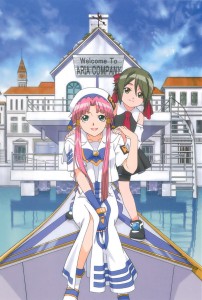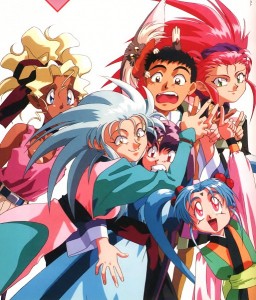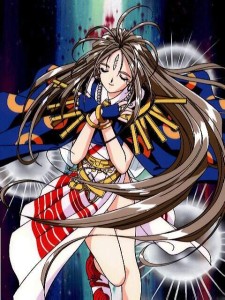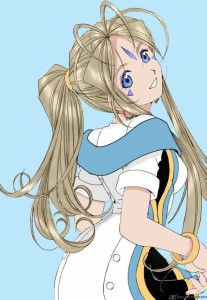Anime Wish-List Grab Bag: From Goddesses to Gondoliers
by RadiumEyes, HSM team writer
It never ceases to amaze me how diverse anime became over the decades – Japan’s earliest forays into animation come to us from 1917, and the market expanded exponentially since Astro Boy debuted on television in 1963.
Most of the early animated productions from Japan are now lost, thanks to the Kanto earthquake of 1928, so we’re blessed to have extant examples prior to that tragic event; these early shorts showed how far anime had come since its nascent period. If one were to compare the 1917 short Nakamura Gatana to an episode of K-On, one would quickly notice a difference in art style and storytelling; the Taishō period brought us some nice early works, several of them using cut-outs (using sheets known as chiyogami; cel animation would become standard in the 1920s). Early anime had adaptations of folklore and historic events; this changed during the 1960s, when Japanese studios began producing original content (not based directly on folkore or or history), most of them adaptations of manga. Astro Boy helped usher in the dominance of televised anime; Tezuka’s little cyborg became a famous figure, and the first in a long line of robotic anime characters.
Today, when people think of anime, they conjure up images of such productions as Mobile Suit Gundam, Speed Racer, Haruhi Suzumiya and a host of others with diverse art styles, themes and stories. As I reflect on my first article for Home, I realize how long the “anime wishlist” could go on – there are so many to choose from, but as with film in general, a select few stand out as hallmarks of the medium. This is why, for this wishlist, I intend to focus on other shows that could feasibly work within the framework of Home. As a note, this comes after several Ultraman items debuted on Home a while ago; the franchise celebrates its 50th anniversary this year, so happy birthday, Ultraman.
A perennial favorite, Ah! Megami-sama began as a serialized manga in 1988, with its first tankōbon released in 1989. So it would be a year late to celebrate the manga’s 25th anniversary, but we could still pay tribute to the tankōbon release – the manga is still ongoing, making it one of the longer-running works in Japanese comics.
The story centers on hapless college student Keiichi Morisato, whose luck leaves a bit to be desired; the first season of the TV series shows him interacting with the Auto Club, of which he is a member, and his embarrassment over their antics is palpable. However, his bout of poor luck soon comes to an end when a certifiable goddess visits his dorm room, offering one wish – and Keiichi asks for a goddess like her to remain by him. After some initial trouble (they’re kicked out of the door for violating the rules – no girls allowed, apparently), they find a new home in a temple.
For Home, a celebration of this seminal work can come in the form of costumes of the three main goddesses – Belldandy, Urd and Skuld, all based on the Norns of Norse mythology. Keiichi Morisato, the male protagonist, happens to be your average Joe, so translating his likeness into Home could run the risk of it being generic. However, he’s still unique, as are his senpais Tamiya Toraichi and Otaki Hikozaemon.
Six characters, six costumes – that can work out wonderfully.
As for other items, there’s Banpei, the humanoid robot that Skuld built, who can be a companion; think of having your very own guardian robot by your side. The temple that Belldandy and Keiichi reside in can also be tapped for a personal space – the Tokari-honganji acts a central setting, along with Nekomi Tech.
 Going a little further ahead in time, Aria began as a manga series, the first (known as Aqua) running in Stencil from 2001 to 2002; three anime adaptations followed. The series features a group of fledgling gondoliers as they practice on a terraformed Mars; in the context of the story, humanity settled Mars, calling it Aqua, while Earth received the appellation Manhome.
Going a little further ahead in time, Aria began as a manga series, the first (known as Aqua) running in Stencil from 2001 to 2002; three anime adaptations followed. The series features a group of fledgling gondoliers as they practice on a terraformed Mars; in the context of the story, humanity settled Mars, calling it Aqua, while Earth received the appellation Manhome.
I simply adore the costumes featured in this series; Mizunashi Akari and Aika S. Granzchesta make for extraordinarily likeable characters, and their work in Neo-Venezia (yes, they made a Venice on Mars) informs each episode. Having costumes for those two, along with Alice Florence and Akira E. Ferrari (two of the Three Water Fairies, famous professional gondoliers or undines), would be excellent; they’d fit in with the anime fare already offered. Neo-Venezia happens to be a beautiful city, and being able to traverse the canals would bring some tranquility – there could even be a game involved, where you attempt to become an undine by acting as a tour guide. Think of it – you begin as a Pair (the series’ term for a neophyte gondolier), then graduate to Single and finally to Prima. Once you achieve the lattermost status, you can earn a special reward indicating your graduation.
Now for an older series – Tenchi Muyo!
The original OVA series remains the most popular; it introduced the world to the hapless Tenchi Misaki and the bevy of beautiful women whom he meets after they arrive on Earth. The girls of this show are extraterrestrial, and one of them, Ryoko, fled to Earth after being chased by Tenchi’s grandfather centuries ago. Through Tenchi’s curiosity over a restricted section of the shrine, he visits the area in question and inadvertently awakens Ryoko; the OVA series begins with Ryoko seeking revenge on the Misaki family for her long incarceration, and several other characters join as the series progresses.

Ryoko, Ayeka and Washu all stand out among the cast – Ryoko happens to be the first of the girls Tenchi meets, after he enters the cave near his family’s temple and awakening her from her centuries-long slumber. Maybe having a fully-body costume would work, if one wishes to add unique animations to it; Ryoko, in particular, has incredible power, and seeing her in action would be a great sight to behold. With Ayeka, she has her traditional Juraian royal garb and battle suit, which can be sold separately; her two bodyguards can also be included as male costumes. These two bodyguards, Azaka and Kamidake, appear typically as logs, but in Tenchi Universe they share their name with two Juraian knights; their knight costumes would be fun to work with.
As for Tenchi himself, he had a battle suit worn while fighting Kagato – the one antagonist of the original six OVA episodes. Now, that does bear some explanation. Tenchi Muyo, as a franchise, encompasses the 20 OVA episodes of the original series as well as various TV series; another OVA series, released as Tenchi Muyo! War on Geminar in the United States, also exists. The first, and most popular, OVA series first had six episodes to its name – when interest in the series grew, a 45-minute was released in January 1994. The second batch of six episodes followed, capped off by a second special.
The three shows mentioned above all have a prominent female cast, with the male protagonists being average citizens – the exception being Aria, which really focuses on the fledgling undines and the Primas who teach them. That series doesn’t quite have a male protagonist, due to the story’s central narrative; still, there are plenty of characters to choose from, and the diverse artistic designs of each show complement the stories of each. These productions happen to be favorites of mine, and seeing the characters make a Home debut would thus be an awesome thing for me – with Ultraman costumes and companions now out, who knows? We may very well see more IP-based content in the future.
Share
| Tweet |




 Twitter
Twitter
Out of all of those, I’ve only seen Tenchi Muyo! (One of my very personal favorites). Hello Kitty on the other hand, I haven’t seen the anime series, but I do know somewhat about that cat.